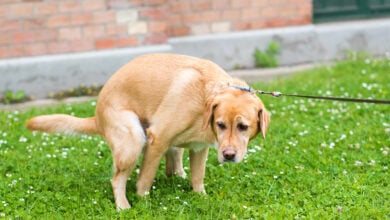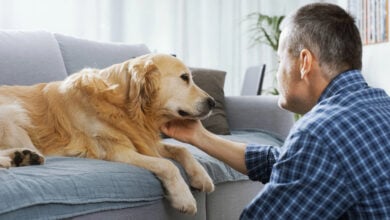Is Your Dog Panting & Pacing? Discover 15 Possible Reasons Behind The Behavior
When you purchase through links on our site, we may earn a commission. Here’s how it works.
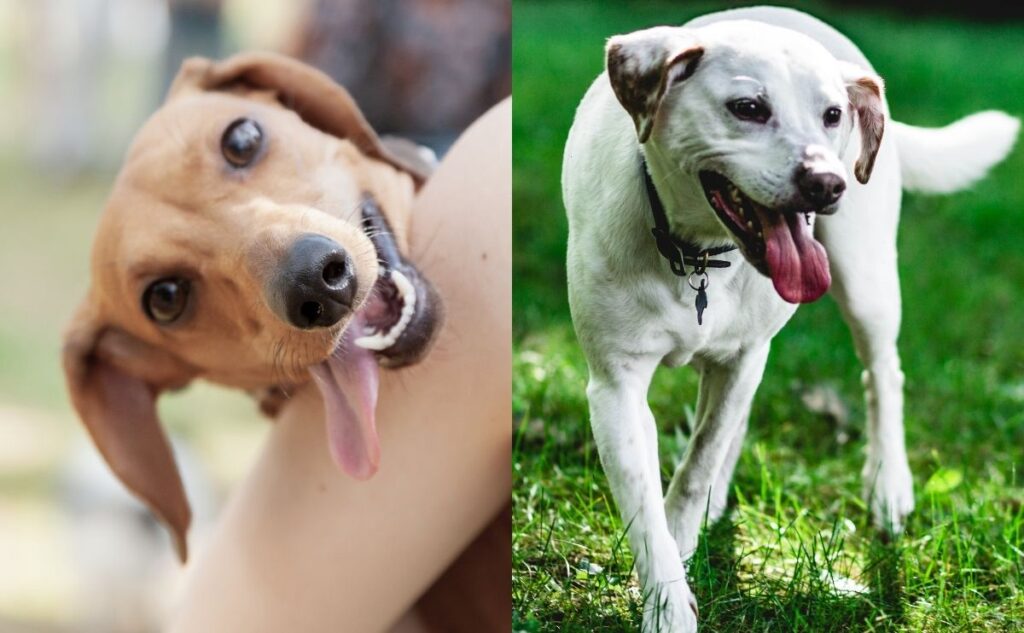
Panting is a completely normal behavior in dogs, most often associated with helping a dog regulate their body temperature. But what if your dog is panting and pacing relentlessly around the house or yard, unable to settle down? Is this also normal behavior, or could something be seriously wrong?
Table of Contents
When your dog starts pacing or panting excessively, it’s often a clue that something’s not quite right. But what could it be? The truth is, panting and pacing are vague symptoms that could signal a wide range of physical, emotional, or behavioral issues. And since your dog can’t tell you exactly what’s happening, connecting the dots is up to you.
Observing your dog closely for any additional symptoms and noting when and how often the panting and pacing occur will help your veterinarian more accurately diagnose what’s wrong. Your vet may recommend lab work or X-rays to first rule out physical health problems. Your veterinarian may then discuss possible behavioral causes and how to treat them. To help you stay ahead of the game, we’ve outlined 15 possible reasons why your dog may be panting and pacing—and why you should never ignore these signs.
1. Pain

When a dog is in pain, they may exhibit various signs and symptoms. Pay attention to changes in any of the following:
- Appetite: Pain can cause a loss of appetite or make it uncomfortable for your dog to chew or swallow.
- Behavior: Pain can make dogs feel more vulnerable or overwhelmed, leading to aggression, irritability, or withdrawal
- Grooming: Dogs often lick or bite at areas that hurt in an attempt to soothe themselves. You may notice them licking their paws, joints, or other painful areas.
- Movement: A dog with limb, joint, or paw pain may limp or have difficulty walking. They might put less weight on one leg or avoid moving it altogether.
- Posture: Pain in muscles, joints, or bones can make movement uncomfortable, causing your pup to adjust their posture to reduce pain.
- Vocalization: Dogs vocalize (e.g., yelping, whimpering, and whining) when they’re in discomfort or distress, especially if the pain is acute or sudden.
Panting, especially at odd times—such as the middle of the night—can be a sign of pain or discomfort. Your pup may also pace restlessly—circling, walking back and forth, or being unable to settle into a comfortable position. Your pooch may also be reluctant to lie down and rest. And, if they do lie down, they might seem uncomfortable and unable to find a position that provides relief.
If your pet displays any of these signs, it’s essential to monitor them closely and consult a veterinarian. Pain can stem from a wide range of conditions, including injury, dental issues, infections, injury, or internal problems. Much like older humans, older dogs are prone to developing arthritis, which can lead to chronic joint pain. A vet will help determine the underlying cause and recommend an appropriate course of action. This may include pain management or further diagnostic tests.
Diagnosing and treating the cause of your dog’s pain can be expensive. Pet insurance can help provide some relief. Read our pet insurance reviews to find a company that can assist you in unexpected situations.
2. Exercise
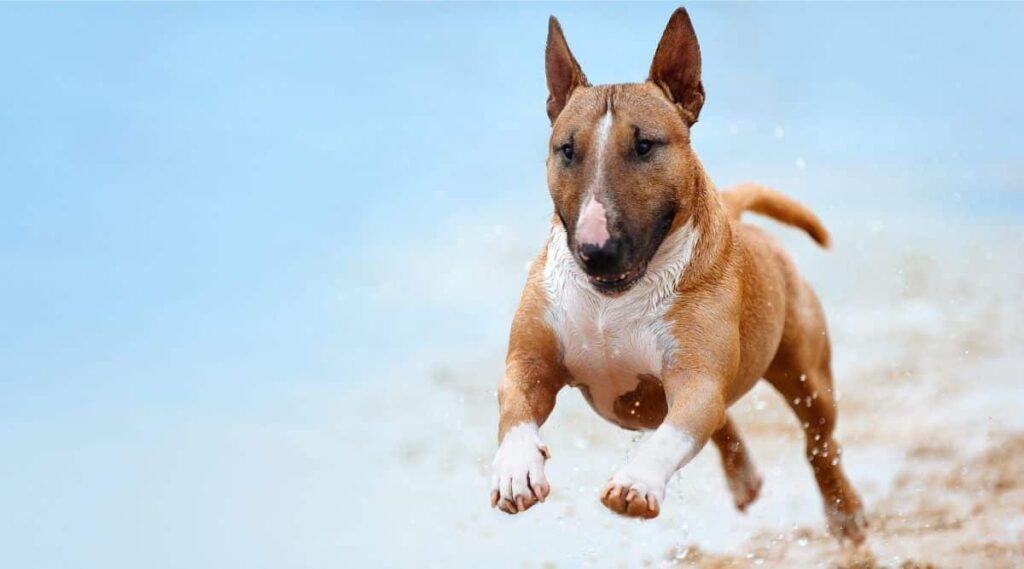
Dogs pant as a natural mechanism to regulate their body temperature. Unlike humans, who sweat to cool off, dogs primarily rely on panting to dissipate heat. Panting helps canines regulate their body temperature by increasing airflow over mucous membranes in their mouth and nose. As air passes over these areas, the evaporation of moisture helps to cool the dog’s core body temperature.
Panting can be more noticeable in warmer weather or environments with poor ventilation. In these situations, panting can become more intense or frequent as the dog tries to bring its temperature down to a comfortable level.
Panting often occurs during and after physical activity. Alongside panting, pups may also exhibit other behaviors like letting their tongues hang out or stretching out to relax. These physical signs indicate that they are content and satisfied after expending energy. They may even lie down and rest on a cool surface until they’ve sufficiently recovered.
However, not all panting after exercise indicates that a dog is simply cooling off. In some cases, panting can also be a sign of overstimulation or an indication that the dog is still restless. For example, if your dog is pacing or unable to settle down after a play session, they may want more playtime. This is especially common in high-energy breeds that enjoy activity and may be difficult to tire out.
It’s also important to consider that excessive panting after exercise could signal an underlying health issue, especially if the panting is prolonged or accompanied by other signs of distress, like drooling, lethargy, or difficulty breathing. If your dog is panting after a routine activity or seems overly exhausted, it might be worth consulting with a vet to rule out other health conditions.
In general, understanding your dog’s behavior can help you better cater to their exercise needs and comfort. Providing a cool, shaded area to rest after physical exertion can help them recover faster. Additionally, always monitor their play environment, as extreme heat or humidity can intensify a dog’s need to pant. With proper care and observation, you can ensure your pooch enjoys exercise while staying safe and healthy.
3. Separation Anxiety

Dogs exhibit a range of behaviors when they are anxious, including excessive panting and pacing. When dogs experience anxiety, their bodies can enter a heightened state of alertness, triggering panting as part of the “fight or flight” response. Pacing, similarly, is a sign of restlessness or an attempt to self-soothe in situations that cause unease. In the case of separation anxiety, these behaviors can become especially pronounced when the dog is left alone or anticipates being left alone.
Separation anxiety is one of the most common forms of anxiety in dogs. Canines suffering from separation anxiety can become intensely attached to their human companions. This attachment can make it challenging for pet owners to leave their dogs alone, as the dog’s anxiety is triggered when the owner departs, leading to behaviors like panting, pacing, whining, barking, and destructive actions.
While panting and pacing are common signs of separation anxiety, it’s important to note that these behaviors may also indicate other issues. Therefore, if your dog’s panting and pacing seem excessive or unusual, a visit to the veterinarian is essential. The vet will first rule out any underlying medical conditions that could be contributing to the behavior.
Managing separation anxiety can be challenging, mainly because it’s not always possible to take your dog everywhere with you. Treatment options vary depending on the severity of the condition. Typically, a combination of behavioral modification, environmental changes, and medication is used.
Behavioral techniques may involve gradually desensitizing the dog to being left alone, starting with short absences and progressively increasing the duration. Environmental changes might include leaving on calming background noise, providing puzzle toys, or creating a safe, comfortable space for your pet to retreat to when you’re gone. In the most challenging cases, your vet may refer you and your dog to a veterinary behavior specialist. With the right approach and patience, many dogs can learn to cope with separation anxiety.
4. Storm Phobia
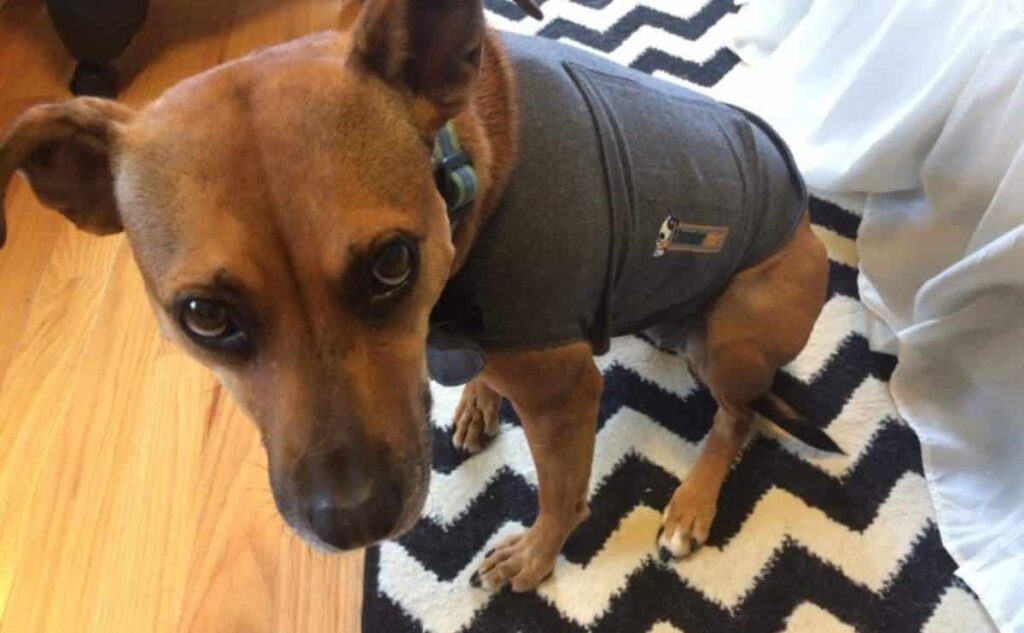
Does your pet’s panting and pacing always seem to coincide with the approach of a seasonal storm? If so, your pup may be experiencing a condition known as storm phobia, which is a fear of thunderstorms. This form of anxiety is quite common in canines. It can be triggered by various elements associated with storms, including thunder, air pressure changes, lightning, and the smell of rain. Storm phobia can manifest in different ways, but it often involves behaviors like excessive panting, pacing, hiding, trembling, and vocalization, such as barking or whining. In severe cases, some dogs may even try to escape the home or become destructive out of fear.
The good news is that storm phobia can often be mitigated with the proper management strategies. If you suspect your pooch has storm phobia, it’s essential to consult your veterinarian for advice on managing the condition. Your vet can help determine the severity of your pup’s anxiety and create a personalized treatment plan.
In many cases, a combination of behavioral techniques and environmental adjustments can make a significant difference. For example, distracting your dog with their favorite toys or treats can help take their mind off the storm. Closing windows and curtains can also help reduce their anxiety.
Another helpful tool for calming storm-phobic dogs is a white noise machine, which can mask the sounds of thunder. Some dogs may also benefit from the gentle pressure provided by a ThunderShirt. This vest is designed have a calming effect similar to swaddling an infant.
If these techniques aren’t enough, your veterinarian may recommend anti-anxiety medications or supplements to help your dog manage their fears during storms or as part of a longer-term treatment plan. More advanced treatment options may be also necessary, such as behavior modification therapy or desensitization. Working with a veterinary behaviorist or a certified dog trainer who specializes in fear-based behaviors can be especially helpful in addressing severe storm phobia.
5. Cushing’s Disease

Cushing’s disease is a condition that occurs when a dog’s adrenal glands produce too much cortisol—a hormone that plays a key role in regulating stress responses and maintaining a healthy immune system. According to the U.S. Food and Drug Administration (FDA), 80% to 85% of Cushing’s disease cases in dogs are triggered by a tumor on the pituitary gland, which stimulates the adrenal glands to produce excessive amounts of cortisol. In other cases, the adrenal glands may develop a tumor, directly causing the overproduction of cortisol. This imbalance in hormone levels can significantly affect your dog’s overall health and behavior.
The signs of Cushing’s disease can vary but often include:
- Abdomen enlargement, resulting in a “pot-bellied” appearance
- Excessive panting
- Fragile skin
- Hair loss
- Increased thirst
- Increased urination
- Lethargy
- Recurrent skin infections
If left untreated, Cushing’s disease can lead to more severe health issues. This includes diabetes, high blood pressure, and a suppressed immune system.
To diagnose Cushing’s disease, your veterinarian will typically perform a series of specialized tests, including blood work, urine analysis, and potentially diagnostic imaging, such as an ultrasound. These tests help determine the underlying cause of the cortisol overproduction. Once diagnosed, treatment options may include medications that help control cortisol levels. Radiation therapy or surgery may be necessary to shrink or remove the tumor. With proper treatment, many dogs with Cushing’s disease can live a long and comfortable life.
6. Cognitive Dysfunction

Is your dog pacing at night? If your dog is older, the pacing and restlessness could signify canine cognitive dysfunction (CCD). CCD is a condition often compared to Alzheimer’s disease in humans. Older dogs experience changes in their brain structure and function, leading to confusion and disorientation, especially at night. While these behaviors might seem like typical aging issues, their timing and frequency could indicate serious cognitive decline.
In addition to pacing, your dog may appear confused or lost—even in familiar environments. They might start vocalizing more than usual, especially at night when things are quieter. Affected dogs may also show decreased interest in activities they once enjoyed, such as playing with toys or going for walks. These changes can be distressing, both for your dog and for you as an owner, as they may signal that your pet’s quality of life is declining.
To confirm whether these signs are related to cognitive dysfunction or if another underlying condition is at play, your veterinarian may recommend a range of diagnostic tests, such as an MRI or blood work. These tests help rule out other neurological or medical issues that could cause similar symptoms. It’s important to differentiate between CCD and other potential health problems, as treatment options vary depending on the cause.
While CCD itself cannot be cured, there are treatments and management strategies that can help slow its progression and improve your dog’s comfort. Your veterinarian may suggest dietary changes, including food formulated with antioxidants and omega-3 fatty acids to support brain health. Neuroprotective supplements like lion’s mane mushroom and specific medications, such as selegiline, can help alleviate some symptoms by improving neurotransmitter function in the brain. Additionally, creating an environment with interactive toys, regular routines, and mental challenges can help keep your pet calm and engaged. Check out our personal experience using video games for doggy dementia.
7. Vision Loss
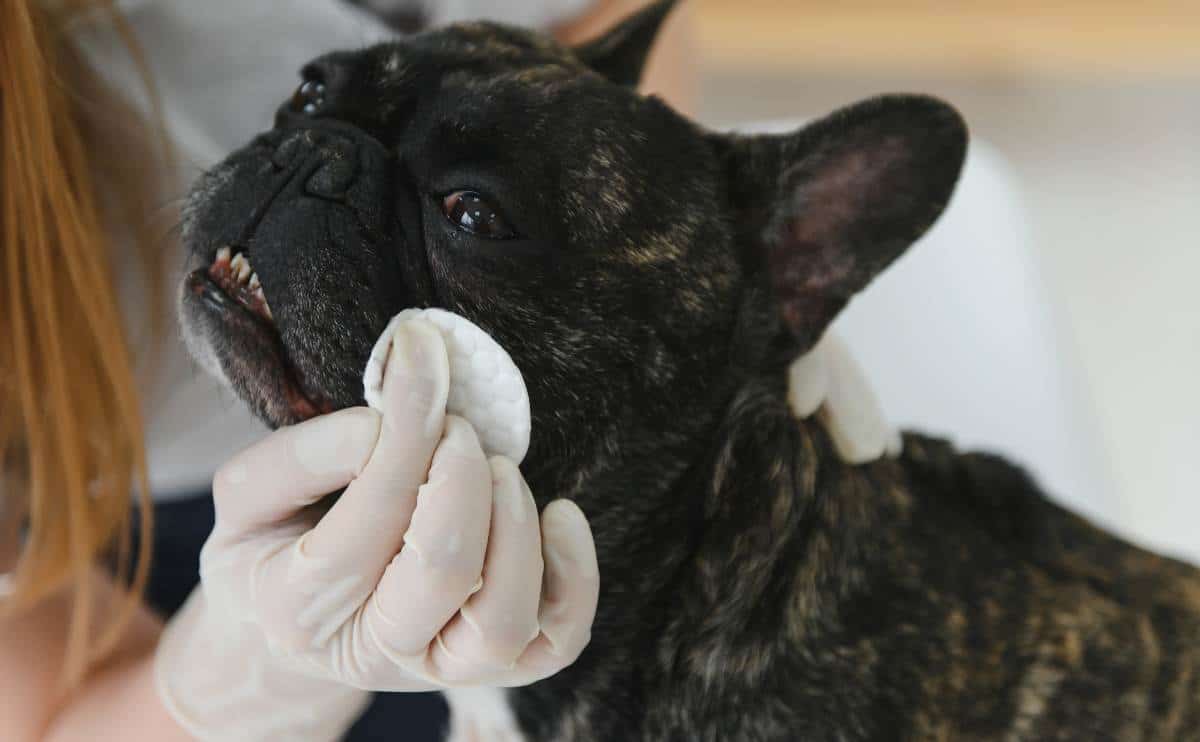
Unlike humans, dogs’ primary means of interpreting their environment are their senses of smell and hearing. This instinctive reliance on other senses often makes it difficult for pet owners to recognize that their dog may be experiencing vision loss.
One of the first signs that a dog may be struggling with vision loss is a decrease in their ability to see in low-light conditions. Pacing, panting, and restlessness can stem from the disorientation that comes with being unable to navigate their environment. While dogs are excellent at memorizing the locations of familiar objects, vision impairment can lead them to bump into furniture, walls, or other obstacles they would typically avoid. You may also notice your dog hesitating to go up or down stairs because they struggle to judge the depth or the presence of steps.
In addition to nighttime behavior changes, other signs of vision loss could include your dog’s difficulty tracking moving objects or becoming startled by things they didn’t see coming. For instance, your dog might miss an opportunity to catch a thrown toy or may seem less responsive to visual cues like your gestures or body language. It’s also possible that your dog might start to show signs of increased clinginess or nervousness, particularly in unfamiliar environments or when navigating new spaces. These behavioral shifts can be subtle at first, making it challenging to pinpoint vision loss as the cause.
If you suspect your dog is losing their vision, it’s important to consult your veterinarian. There may be treatment options to manage or correct the condition. If the vision loss is not treatable, your veterinarian can provide guidance on helping your dog adapt to their new lifestyle. Strategies include maintaining a consistent home environment, using tactile or audible cues to guide them, and providing extra comfort and reassurance.
Our Personal Experience With Canine Vision Loss
Our 14 year-old-dog Lily’s hearing and sight functions have really declined in the past two years, causing her to pant in the night. To calm her nerves, we have started plugging a pheromone diffuser into our bedroom wall near her bed to help her sleep. On nights when it is really bad, we also give her a Composure treat, and she calms down in about 15 minutes.
– Michelle Schenker, rescue dog parent
8. Medication Side Effects
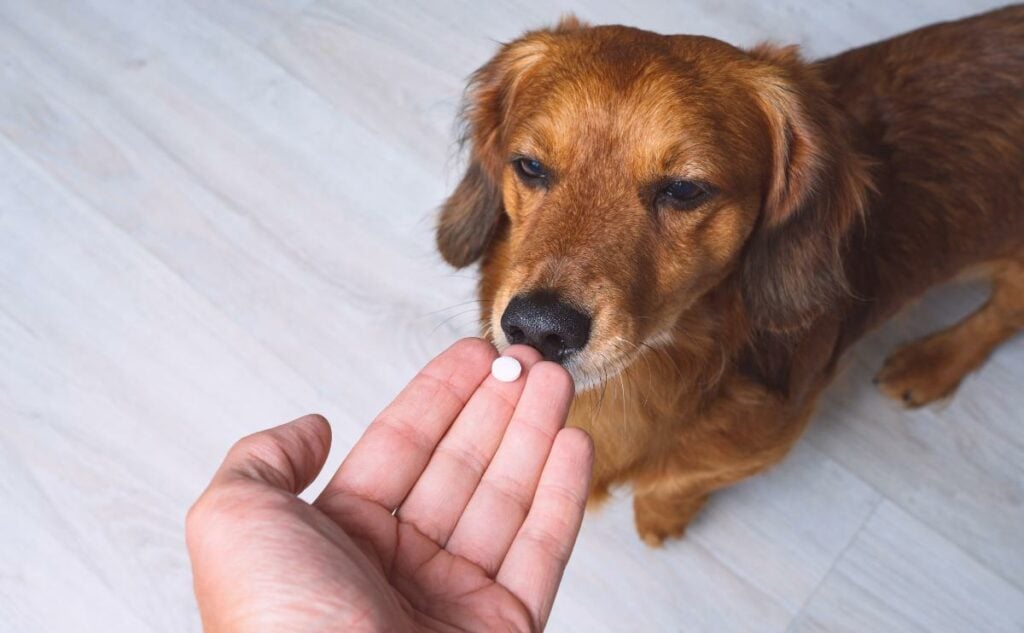
Is your dog currently taking any prescribed medications? Many medications, even those intended to improve your dog’s health, can cause side effects such as panting, pacing, and restlessness. These side effects might be mild, but they can also be distressing for both you and your dog.
Medications like glucocorticoids (e.g., prednisone) are known to cause short-term side effects like panting and agitation. If your dog has been given sedatives or opioid pain medications following surgery or a medical procedure, they may also experience panting or restlessness as the drugs are metabolized. Medications given for conditions such as flea and tick prevention or heartworm prevention can also cause changes in behavior, including panting and pacing.
Here are some other common medication side effects to watch for:
- Behavioral changes (e.g., increased anxiety or irritability)
- Changes in appetite (increased or decreased)
- Diarrhea or vomiting
- Excessive thirst or urination
- Increased panting or heavy breathing
- Lethargy or decreased energy
- Loss of coordination or stumbling
- Restlessness or pacing
- Skin rashes or swelling
- Unexplained tremors or shaking
If you notice any of these symptoms, it’s crucial to contact your veterinarian as soon as possible. They can help determine if the symptoms are related to the medication and, if necessary, suggest adjustments to your dog’s treatment plan.
9. Heat Stroke

Heat stroke, or hyperthermia, is a life-threatening emergency that occurs when a dog’s body temperature exceeds 105°F. Early signs include excessive panting, restlessness, and unsteady movements. If untreated, symptoms can escalate to difficulty breathing, vomiting, or collapse. This condition often arises from scenarios like being left in a parked car, exercising in hot weather, or lacking shade and water in high temperatures. Certain dogs, including brachycephalic breeds (e.g., Bulldogs and Pugs), overweight dogs, and those with heart conditions, are especially vulnerable.
How to Help a Dog with Heat Stroke:
- Move the dog to a cool, shaded area immediately
- Direct a fan at them to improve airflow
- Apply cool, wet towels to the groin, armpits, and neck
- Wet their paws and ears with cool water
- Offer small amounts of cool water to drink, but avoid ice water or forcing them to drink
- Monitor their condition and transport them to a veterinarian without delay
Veterinary care is essential in managing potential complications like dehydration or organ damage. So, you must transport your dog to a clinic as soon as possible.
By recognizing the signs of heat stroke early and acting swiftly, you can protect your dog’s health and well-being. Prevention is the best approach—take proactive steps to keep your dog safe during hot weather.
10. Obesity

If your dog has been gaining weight and you’ve noticed increased panting and pacing, the extra pounds could be the culprit. Obesity in dogs, just like in humans, can lead to a wide range of health issues that affect their quality of life. Recognizing and addressing weight gain early is key to preventing more serious complications.
Excess body fat can make breathing harder for your dog, especially during physical activity or in warm weather. This extra effort to breathe often leads to panting as your dog tries to cool down and compensate. Obesity also places additional strain on joints, which can cause discomfort or pain. As a result, your pup may pace or have difficulty getting comfortable, signaling the need for intervention.
Schedule a veterinary exam if your pooch exhibits persistent panting, restlessness, and weight gain. A veterinarian can perform a physical assessment and conduct lab tests to rule out underlying health issues like hypothyroidism or Cushing’s disease, which can contribute to weight gain. Once any medical conditions are ruled out or treated, your vet can guide you in developing a safe weight-loss plan tailored to your dog’s needs.
Weight management plans often include dietary adjustments, portion control, and increased physical activity. Your vet may recommend switching to lower-calorie food or adding high-fiber options to help your pet feel fuller while consuming fewer calories. Regular exercise, appropriate for your dog’s breed and fitness level, is also essential. By addressing obesity early and implementing a healthy lifestyle, you can reduce your dog’s panting, pacing, and risk of developing more severe health problems, helping them live a longer, happier life.
11. Gastrointestinal Distress
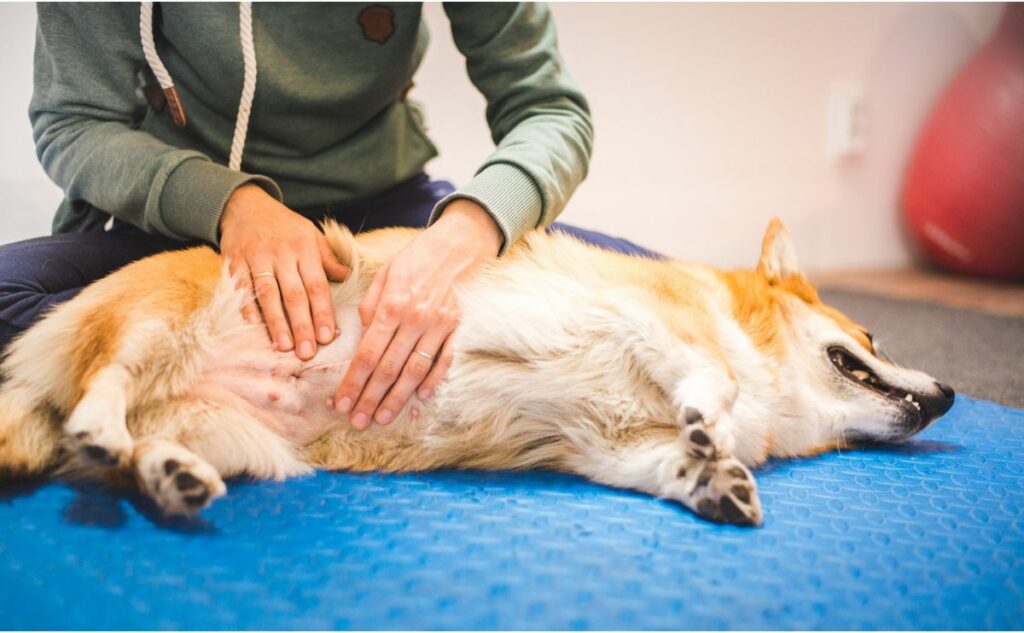
Panting and pacing can sometimes indicate underlying gastrointestinal (GI) distress in dogs. A wide range of GI conditions, from mild to severe, can cause discomfort or pain that leads to these behaviors. For instance, diarrhea may make your dog anxious and uncomfortable, as the frequent need to go outside disrupts their routine. Similarly, conditions like pancreatitis can cause severe abdominal pain, leading to restlessness and excessive panting.
In addition to panting and pacing, you may notice other signs of GI illness, such as vomiting, diarrhea, loss of appetite, or lethargy. These symptoms can disrupt your dog’s daily life and signal significant discomfort or pain. Beyond the immediate discomfort, GI issues can have more serious consequences if left untreated. Persistent vomiting or diarrhea, for example, can lead to dehydration, electrolyte imbalances, and abnormalities in lab work that may require urgent medical intervention.
It’s essential to seek veterinary care promptly if your dog shows these signs of GI distress. A veterinarian can perform a thorough examination and run diagnostic tests, such as blood work, imaging, or stool analysis, to identify the underlying issue. Conditions like gastroenteritis, intestinal blockages, or infections may require specific treatments, ranging from medication to supportive care like fluids or dietary changes.
Early intervention not only relieves your dog’s discomfort but also prevents complications that can arise from untreated GI issues. Your veterinarian may recommend a temporary switch to a bland diet or prescribe medications to manage symptoms and promote healing. Most GI problems can be resolved or managed effectively with proper care, helping your canine return to their normal, happy self. Recognizing and addressing these signs early protects your dog’s health and well-being.
12. Heart Disease
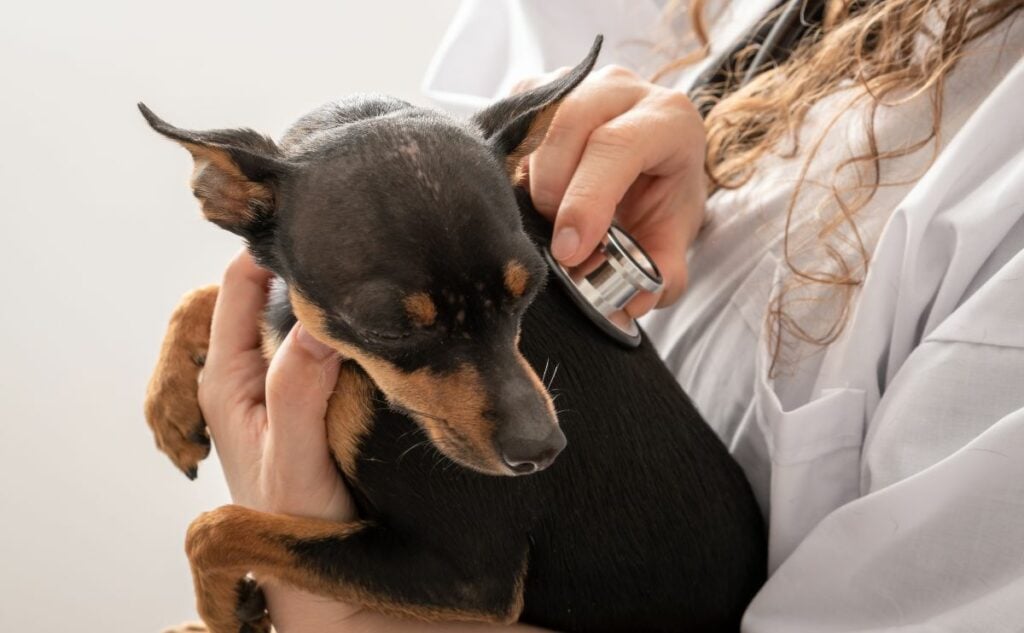
Heart disease is a serious condition that can significantly affect your dog’s quality of life. Dogs with heart disease often exhibit symptoms such as difficulty breathing, coughing, lethargy, loss of appetite, and abdominal swelling. These symptoms may appear gradually or suddenly, depending on the severity of the condition.
Panting and pacing in dogs with heart disease may occur because the heart struggles to pump blood effectively, leading to reduced oxygen levels in the body. This can make even routine activities exhausting and uncomfortable for your dog. Anxiety may exacerbate these behaviors as your dog tries to cope with their discomfort. Additionally, fluid buildup in the lungs or abdomen—common in conditions like congestive heart failure—can cause further breathing difficulties and restlessness.
To confirm a diagnosis of heart disease, your veterinarian will perform a thorough physical exam and may recommend diagnostic tests. These can include an electrocardiogram (EKG) to assess the heart’s electrical activity, a blood pressure check, X-rays to evaluate the size of the heart, and an echocardiogram to provide detailed images of the heart’s structure and function. Your vet may refer you to a veterinary cardiologist specializing in advanced heart care for animals if needed.
Treatment for heart disease varies depending on the specific condition but often includes medications to manage symptoms, improve heart function, and reduce fluid buildup. Common treatments include diuretics to reduce fluid accumulation, ACE inhibitors to ease the workload on the heart, and beta-blockers to regulate heart rate. Your veterinarian may also recommend dietary changes, such as reducing sodium intake, and implementing gentle exercise tailored to your dog’s capabilities. With proper management and regular veterinary monitoring, many dogs with heart disease can enjoy a good quality of life for months or even years. Early diagnosis and treatment are key to improving outcomes and helping your dog stay comfortable.
13. Neurological Disease
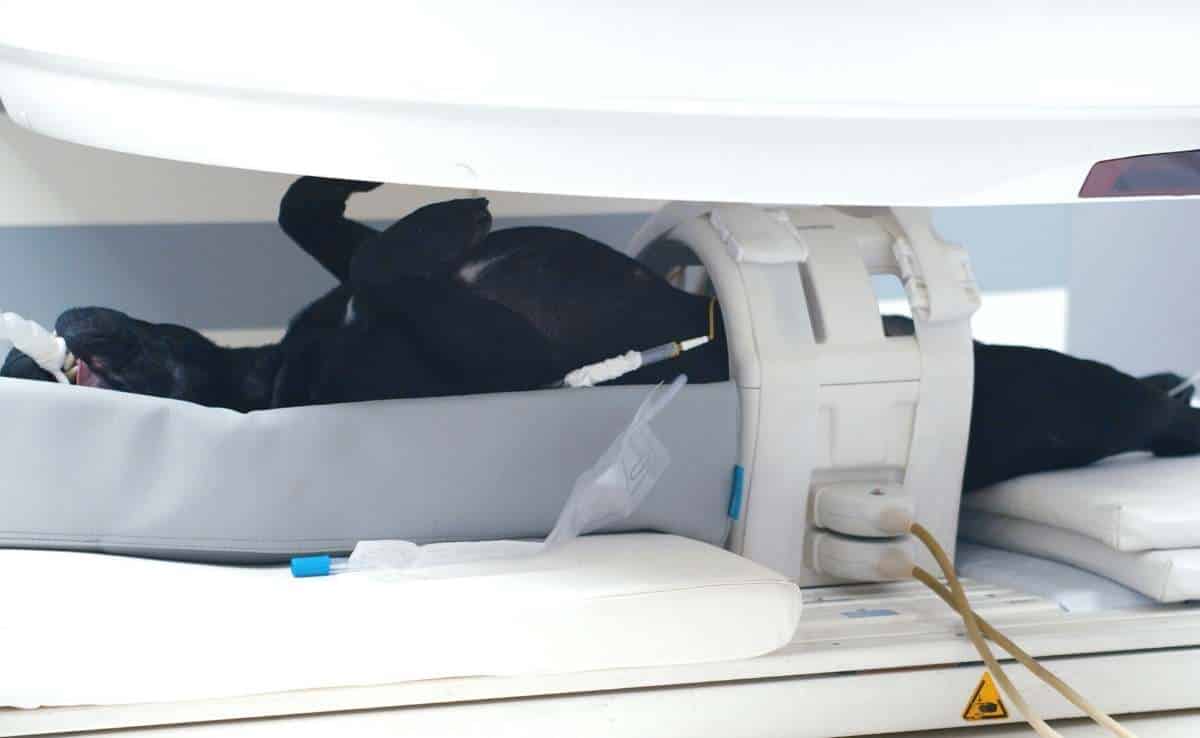
If your dog is panting and pacing, especially at night, your vet may recommend advanced imaging, such as an MRI or CT scan, to rule out neurological conditions. Neurological diseases, including encephalitis (inflammation or infection of the brain), can cause discomfort and anxiety, leading to these behaviors. Additional signs that suggest a neurological issue include seizures, a head tilt, neck pain, or uncoordinated movements often described as “drunk walking.” Another possible cause of these symptoms is a brain tumor, which can disrupt normal brain function and affect your dog’s behavior.
Panting and pacing in dogs with neurological issues can be linked to pain, confusion, or other neurological deficits. For example, encephalitis can lead to inflammation that causes severe headaches or seizures, leaving your dog restless and anxious. Similarly, brain tumors may put pressure on specific parts of the brain, leading to discomfort, disorientation, or changes in behavior. These symptoms often occur alongside other subtle changes, such as altered appetite, lethargy, or unusual postures, which can provide additional clues to the underlying condition.
Treatment for neurological diseases in dogs depends on the specific diagnosis. For encephalitis, medications such as corticosteroids may be prescribed to reduce inflammation. Antibiotics or antifungals may be used if an infection is present. Seizure management with anticonvulsants may also be part of the treatment plan. If a brain tumor is diagnosed, treatment options may include surgery to remove the tumor or radiation therapy to shrink it.
Early diagnosis and intervention are critical for managing neurological conditions effectively. Advanced imaging and a thorough examination can help pinpoint the cause and guide the appropriate treatment plan, ensuring your dog receives the care they need to remain as comfortable and healthy as possible.
14. Respiratory Disease

Panting, rapid breathing, restlessness, and pacing may indicate that your dog is experiencing a respiratory condition. These behaviors are often a response to difficulty breathing or discomfort caused by the inability to get enough oxygen. Other signs, such as coughing, nasal discharge, or wheezing, can provide additional clues to the underlying issue.
Infectious respiratory diseases, such as kennel cough, can affect dogs of all breeds and ages. This condition is highly contagious and can cause symptoms like a persistent cough, gagging, and nasal discharge. Dogs with compromised immune systems, puppies, and senior dogs are particularly vulnerable to respiratory infections. Additionally, flat-nosed breeds are predisposed to brachycephalic airway syndrome, a condition where their anatomy restricts airflow and makes breathing more difficult.
To diagnose the cause of your dog’s respiratory distress, your veterinarian may recommend diagnostic tests to evaluate the lungs and airways. Blood work or a tracheal wash may also be performed to identify infections or inflammation. In some cases, your vet might refer your dog to a specialist for advanced diagnostics.
Treatment for respiratory conditions depends on the diagnosis. For infectious diseases like kennel cough, your veterinarian may prescribe antibiotics, cough suppressants, or anti-inflammatory medications to relieve symptoms and promote recovery. For brachycephalic breeds, treatment may include weight management, medications, or surgical intervention. Early detection and treatment are critical for managing respiratory diseases effectively and improving your dog’s comfort and quality of life.
15. Toxicity

If your dog has a habit of eating anything they can get their paws on, their panting and pacing could be caused by ingesting something toxic. Dogs are naturally curious and often explore the world with their mouths. This sometimes leads to the consumption of foods, plants, or medications that are harmful to them. Toxic substances can affect their nervous, cardiovascular, or gastrointestinal systems, leading to symptoms such as panting, pacing, hyperactivity, vomiting, and, in severe cases, life-threatening complications.
If you suspect your dog has ingested something toxic, it’s crucial to seek veterinary care immediately. Time is of the essence when dealing with poisoning, as early intervention can prevent more serious complications. Your veterinarian may ask about your dog’s symptoms and what they might have eaten. Diagnostics, such as blood work or imaging, may be used to confirm toxicity.
Treatment often involves inducing vomiting, administering activated charcoal to absorb toxins, and providing supportive care like IV fluids to stabilize your dog. In more severe cases, hospitalization and additional treatments may be required.
Prevention is key to avoiding toxic ingestion. Keep harmful foods, medications, and household substances out of your dog’s reach, and educate yourself about everyday poisonous items. If an accidental ingestion does occur, acting quickly can make all the difference in ensuring your dog recovers. Recognizing the signs of toxicity, such as panting and pacing, is essential to keeping your dog healthy and safe.
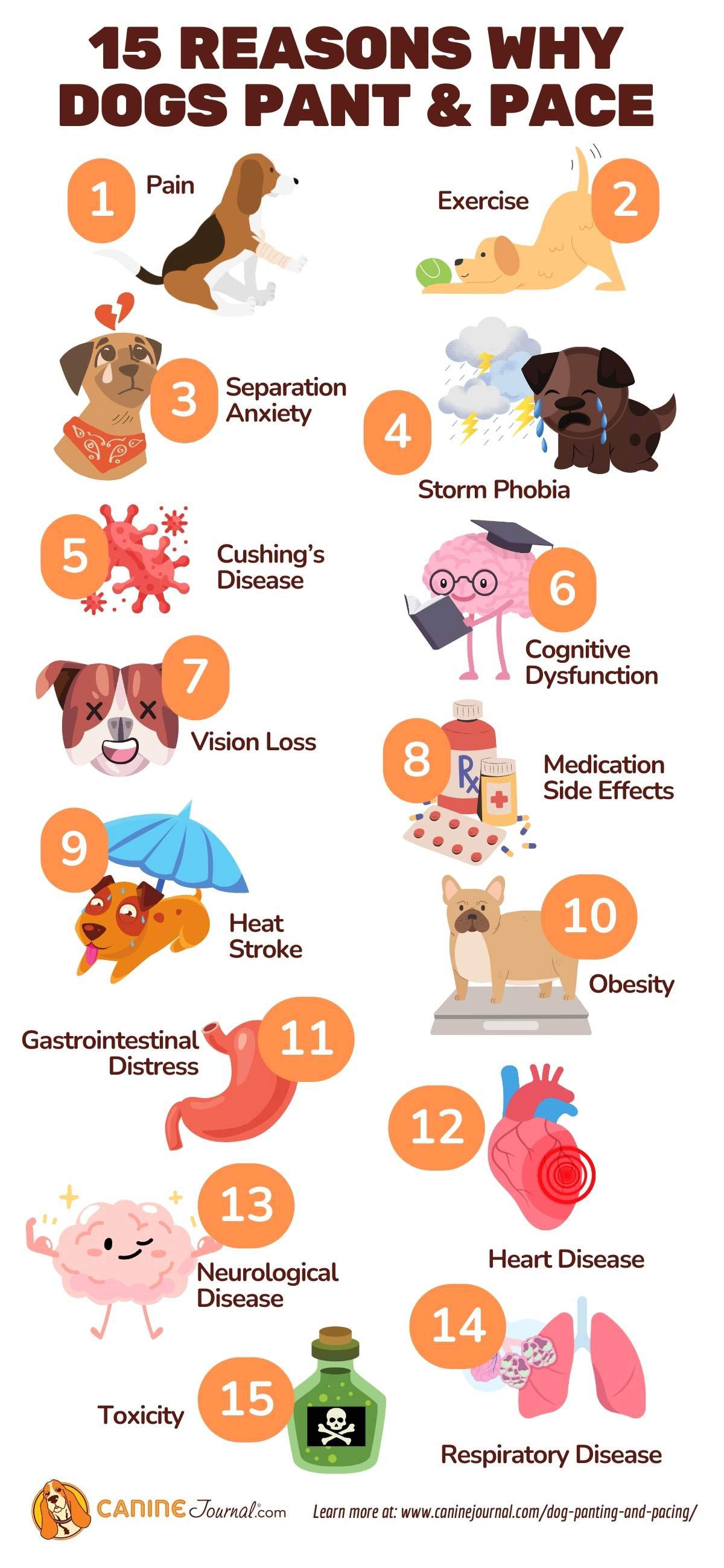
What The Vet Says
According to Dr. Hannah Godfrey BVetMed MRCVS, “Dogs can pant for lots of reasons – it could mean that they’re hot, breathless, anxious, excited, or in pain. On the other hand, pacing is less associated with heat, exhaustion, or being out of breath and is more likely a sign of anxiety, excitement, or pain. Working out whether your dog is panting and pacing because they’re excited or whether it’s something you should be concerned about isn’t always easy.”
She adds, “If it’s warm or your dog has been racing around, try calmly sitting with them somewhere cool to see if they return to normal. If you can’t settle your dog with a calm cuddle or distract them with a walk or toy, then something isn’t right. First, check their surroundings – many dogs will be fearful or distressed hearing fireworks, storms, or other loud noises nearby. If your dog regularly struggles in these situations, your vet can prescribe calming medications or sedation, depending on the circumstances.”
“If there’s no clear reason for your dog to be anxious, they might be disorientated, unwell, or in pain. Older dogs can also suffer from cognitive decline, vestibular syndrome, and other conditions affecting their balance, awareness, or brain function, and the disorientation caused by these conditions can sometimes cause panting and restlessness. So, if you’re unsure why your dog is panting or pacing and can’t calm them down, it’s best to get them checked by a vet.“
When Is My Dog Panting & Pacing An Emergency?
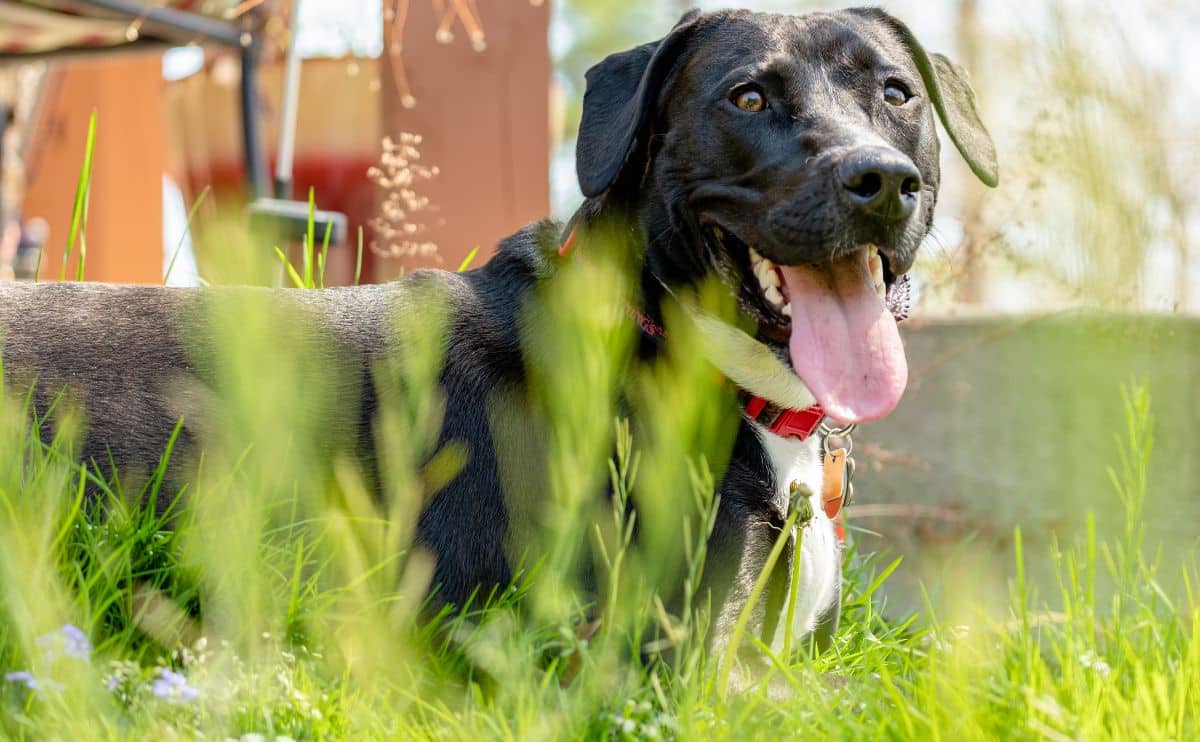
There are some instances when panting and pacing can be a symptom or sign of a more significant, possibly emergency condition. It’s essential to pay close attention to what is happening around your pup and seek emergency treatment if you feel they are in trouble. Should you notice any of the following issues, it’s best to seek immediate treatment.
Respiratory Distress & Trouble Breathing
If your pup is having visible trouble breathing, you must seek emergency treatment as soon as possible. Several medical conditions can cause this, including disease, internal organ damage, poisoning, anaphylactic shock, cardiac disease, respiratory failure, and more.
Ingestion Of Poison Or Foreign Object
A dog panting and pacing, who seems uncomfortable, may be trying to tell you something. If you are suspicious or know that your pup ate something dangerous and is panting, pacing, and acting in a way that isn’t normal, it’s best to have them checked out. Sometimes, even just sharing a bit of your snack can cause your pup some trouble, as not all human foods are safe for dogs. Some foods like grapes, raisins, and onions are very toxic and must always be avoided. (Call the vet immediately if your dog ate grapes, raisins, or a big chunk of onion.)
Abdominal Swelling
If your pup is pacing or panting and has a swollen or distended abdomen, go to the nearest emergency vet as soon as possible. It can be a sign of an internal organ issue and could mean they have an issue with the heart, liver, kidneys, lungs, or pancreas. Take extra caution with a pup that has an underlying medical problem.
Poisonous Bite Or Sting
Insects, snakes, and other animals can bite and sting our dogs. Some of these animals, like snakes, spiders, and insects, can be poisonous, and if your pup has been bitten or stung, they may pant and pace. If you suspect this, it’s best to take them to get checked out right away. You may notice swelling or signs of shock, such as a rapid heart rate, respiratory distress, and a fever.
Excessive Drooling & Whining
If your pup is pacing, panting, drooling a lot, and whining or crying, something else may be happening. It’s best to consult with a vet. Ingesting poison, internal injury, stress, or even severe separation anxiety can cause your pup great distress. Excessive drooling is always something to note. While it may not be an emergency every time, it’s not something to brush off.
Frequently Asked Questions
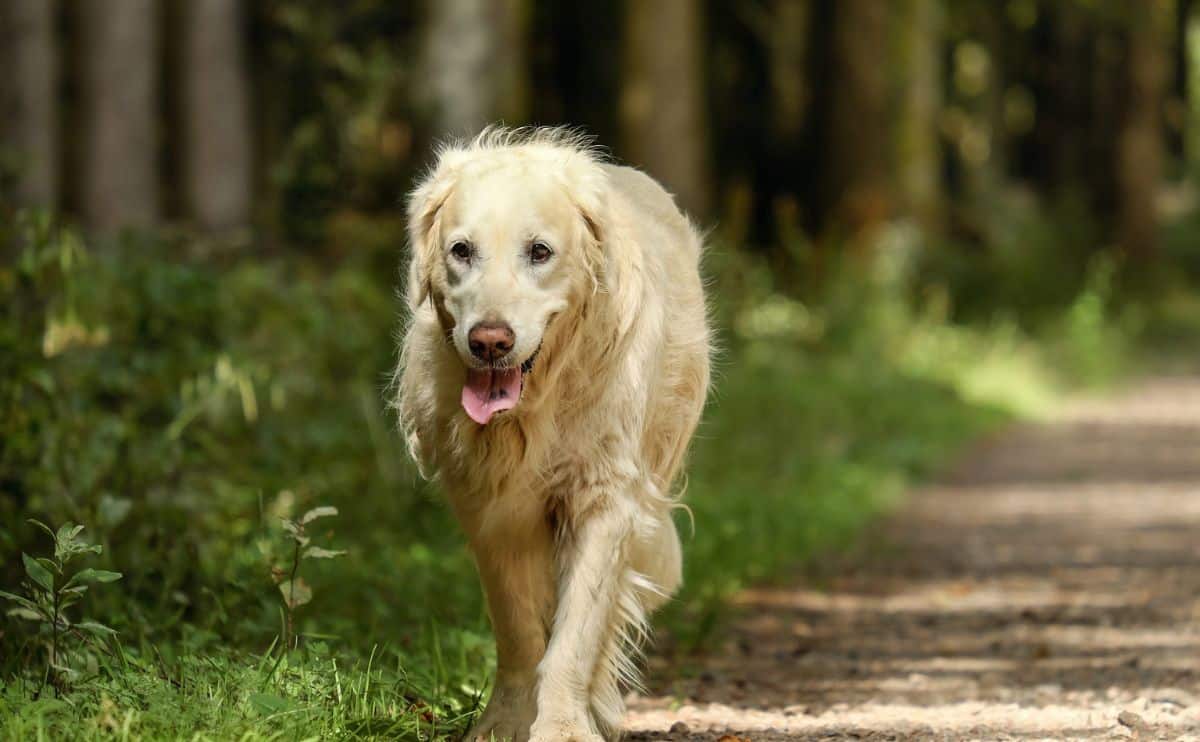
Here are some questions our readers frequently ask about panting and pacing in dogs. Don’t see yours? Ask us in the comments!
Why is my dog panting and pacing at night?
Panting and pacing at night can indicate discomfort, anxiety, or an underlying medical issue. Dogs may exhibit this behavior due to pain, digestive upset, or conditions like arthritis. Stress, such as changes in the household routine or environment, may also cause nighttime restlessness.
What should I do if my dog keeps panting and won’t settle?
Start by assessing the situation. Is your dog overheated, anxious, or showing other symptoms like vomiting, coughing, or lethargy? If the behavior persists or is accompanied by concerning signs, contact your veterinarian. Immediate veterinary attention is critical if poisoning, heat stroke, or another emergency condition is suspected.
How can I prevent panting and pacing in my dog?
Prevention involves addressing potential triggers such as overheating, anxiety, or health conditions. Regular vet check-ups, a balanced diet, exercise, and creating a safe, comfortable environment for your dog can help minimize panting and pacing
Find A Vet You Like And Trust
Determining the cause of your dog’s symptoms, especially ones as ambiguous as panting and pacing can be a long and involved process. Finding a veterinarian you trust is a key step. At the end of the day, you know your dog best, and your veterinarian will take your observations and reports into consideration when determining a diagnosis. Panting and pacing are your dog’s way of telling you something is wrong, and it’s up to you to help find a solution for your canine best friend.
Why Trust Canine Journal?
Kimberly has written about many dog health issues and has first-hand experience with her dog panting and pacing. Fortunately, her dog’s panting is always due to exercise or getting too hot, which are both easily treatable by giving her a rest and a cool down. Her pacing is typically due to separation anxiety, which Kimberly has found sticking to a routine helps her dog. However, there are many other reasons for panting and pacing, which is why Kimberly consulted with multiple vets to provide many reasons why your dog may be panting and pacing.


